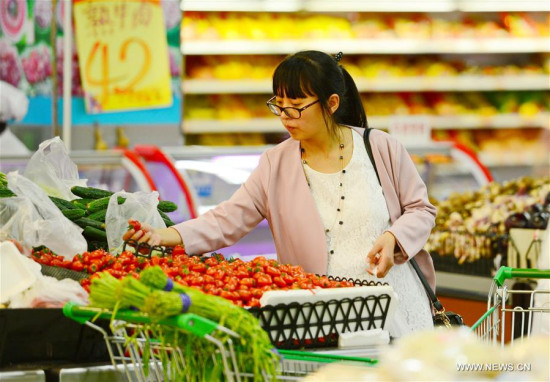
A woman chooses vegetables inside a supermarket in Baoding City, north China's Hebei Province, April 10, 2016. (Photo: Xinhua/Zhu Xudong)
Recent figures have shown that the Chinese economy has generally seen stable growth with deepening supply-side structural reforms, an official from the National Bureau of Statistics said in an article published Monday in People's Daily.
Meanwhile, measures have been taken to expand total demand in the first four months of this year, contributing to economic indicators within expectations, Guo Tongxin said.
First, the consumption and the services sector have served as the main engine for economic growth, said Guo.
"The April data is further evidence that the national economy since the start of this year has grown mainly on domestic demand led by consumption, and that industrial growth is mainly supported by the services sector," Guo said.
That is a positive development of structural adjustments to the economy and industrial upgrading, he said, highlighting progress in such sectors as IT, environment, housing, tourism, culture, health and sports.
Final consumption has contributed a staggering 84.7 percent to economic growth in the first quarter of this year, up 22 percentage points from the same period last year, he said.
The value added of the services sector expanded 7.6 percent in the first quarter, 1.8 percentage points faster than the secondary sector, accounting for 56.9 percent of gross domestic product (GDP), or 19.4 percentage points higher than the secondary sector. Its contribution to economic growth reached 63.5 percent, 29.3 percentage points higher than the secondary sector, according to the expert.
Second, streamlining government administration and the recent introduction of a value-added tax has stimulated market vitality, contributing to early signs of positive results from supply-side structural reforms, Guo said.
Newly registered firms exceeded 1.57 million from January to April, up 27.5 percent from the same period last year, with about 80 percent of them in the services sector.
In addition, tax reductions since last year has lessened the tax burden on Chinese firms by more than 400 billion yuan, while the introduction of the value-added tax on May 1 is expected to cut another 500 billion yuan in tax this year.
Innovation is also playing a key role in China's new economy. New patent licensing has grown another 63 percent in the first four months of this year, following a 61.9 percent growth in 2015. Online retail sales have grown 25.6 percent, 15.3 percentage points faster than that of total retail sales of consumer goods.
On macroeconomic policies, Guo said the stability of macroeconomic policies despite downward pressure on the economy has ensured economic growth within a reasonable range. Higher fiscal expenditure coupled with tax reduction shows a more proactive fiscal policy, with government investment flowing more to public services and products, resources and environmental protection and new industries, he said.
Monetary policies have been moderate with M2 growth cooling down in April, he added, noting that in general, the growth of total money and credit supply and total social financing remains stable and normal.
Meanwhile, unemployment remains generally stable, the expert said.
Although unemployment has risen in some regions due to the economic slowdown and a reduction in excess capacity, the growth of the services sector and entrepreneurship has kept the unemployment rate stable, he said.
Rural-to-urban migrant workers reached nearly 168 million, up 2.9 percent from the same period last year, while the registered unemployment rate saw a slight decline at 4.04 percent by March, he said.
Finally, Guo said the 13th Five-Year Plan approved in March has played an important role in stabilizing and lifting market expectations. The Purchasing Manager's Index (PMI) has entered an expansionary period in March and April for the first time since August, while the Producer Price Index (PPI) saw the first rise in years in March, a strong indicator of rising market confidence by firm managers.
The expert also cautioned that downward pressure would persist for the Chinese economy, given that the rise of the new economy cannot yet cover the decline in traditional sectors.
He suggested focusing on fixing structural supply-side problems in the economy, rather than seek short-term gains and losses.


















































